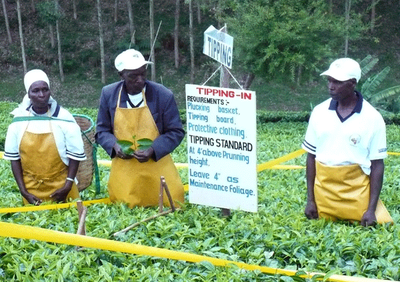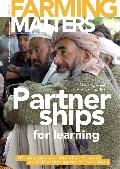Certification is not a “silver bullet” that automatically guarantees sustainable agriculture, although it does bring many positive results. These benefits can be multiplied by paying more attention to the development of skills and knowledge, and to the learning processes in which farmers, extension agents and company representatives are involved.
“Proof” vs “Improve”
Many small-scale farmers aim to certify their production processes, hoping to get better access to markets and higher prices. Different case studies have shown that strengthening the learning processes that are part of such certification schemes can help farmers follow more sustainable practices and attain a wider set of benefits.

A set of standards determines what practices or activities are encouraged or forbidden in the production process, and is intended to improve the process and the end product, so that it meets specific quality demands. Once a set of standards is defined, much emphasis is placed on proving to consumers and other stakeholders that the standards are actually being met.
The intention of a certification scheme is thus to give consumers the proof of principal and to assure them that the product they are buying meets their quality criteria. To convey their message, many certification schemes have launched consumer labels, and back these up with branding campaigns for those labels.
But experience has shown that certification is not a “silver bullet” for guaranteeing sustainable agriculture. Some standards (such as Fair Trade) are successful, although there appear to be many difficulties in expanding beyond niche market segments. Other standards have had a limited impact, or struggle with the non-compliance of farmers or other producers.
In many cases, training, promoting field experiments and investments to improve ways of working can address these problems. These interventions can strengthen certification schemes by contributing to the establishment of more sustainable production processes and more resilient business models.
This article draws on two of a larger number of impact studies of projects where small-scale farmers are involved in certification schemes. These studies show how learning processes contribute significantly to quality, yields and sustainability. We recommend that policy makers and NGOs pay more attention to supporting and encouraging such learning mechanisms and instruments.
Capacity building and certification
One of the longest established projects we looked at was that of Fair Trade fruit production in the province of El Oro, Ecuador. In the early 1990s, fourteen banana producers in this region started the Asociación de Pequeños Productores Bananeros “El Guabo” (or AsoGuabo), and in 1998 they started selling Fair Trade-certified bananas to AgroFair, a European importer. Since then, the association has grown to become an export organisation that includes fifteen local groups, with a total membership of more than 400 producers.
In 2006 they exported 1,727 million boxes, representing 46% of AgroFair’s total banana sales. An in-depth study of the impact of 20 years of involvement with Fair Trade revealed a number of insights about the factors that have contributed to the success of this association.
In many ways, Fair Trade-certified producers appear to have achieved better results than their conventional competitors. Fair Trade farmers have substituted chemical fertilisers with organic ones, carried out cultural measures to control leaf spot disease (Sigatoka) and enhanced nutrient take-up by using more efficient irrigation systems. These changes have increased productivity levels. Major investments in cable ways and improved packing stations have helped to maintain quality while increasing the number of boxes sent abroad.
Compared with their non-Fair Trade neighbours, AsoGuabo members have performed better in terms of yields, production volumes and banana quality. Moreover, they appear to be more inclined to invest money in improving production and packaging; as well as investing in environmental care (and also in health care, and many of them having even bought life insurance policies).
As a result, Fair Trade farmers now own more assets and equipment, have better access to credit and better production strategies. In short, they have improved their livelihoods considerably more than their non-Fair Trade neighbours.
Could this all be attributed to the certification scheme? Yes and no. Given the number of farmers involved and its export volumes, it is clear that AsoGuabo has received considerable financial benefits from the certification scheme.
The standards of the Fair Trade Labelling Organisation specify that buyers should pay a premium of US$ 1 per box, and AgroFair follows these rules. Of this premium, AsoGuabo has used 20 percent for credit provision to enhance further technical improvements, and channelled 80 percent towards social and environmental programmes (i.e. school fees, childcare, health and social insurance).
AsoGuabo has also received technical support from several non-governmental development organisations (including SNV and GTZ) for business development, to improve its quality management systems, and to make effective use of the premium funds. These additional resources have helped AsoGuabo go beyond the minimum requirements for complying with Fair Trade standards.
Beyond niche markets
In response to criticisms that labels like Fair Trade only reach niche markets, new certification schemes are trying to help producers reach mainstream markets. One of the leading examples is the Rainforest Alliance programme, which certifies a range of product categories including fruit, coffee, cacao and tea.
In 2006, the Kenya Tea Development Agency (KTDA), Lipton, ETC East Africa and some institutions affiliated to Wageningen University started working together to try to scale up adoption of Good Agricultural Practices, or GAPs (including, for example, a 7-day plucking interval, storing rain, keeping records, etc.).
The partnership sought to combine certification with the Farmer Field School approach, with the aim of eventually reaching the 500,000 small-scale farmers who regularly work with KTDA. Four pilot field schools were set up and 120 farmers were invited to participate.
The logic of the intervention was based on a number of assumptions. First, it assumed that Farmer Field Schools would broaden farmers’ knowledge about tea production and that they would adopt the set of GAPs. It was also assumed that trained farmers would share their know-how with their neighbours, who would also adopt better practices. This in turn would improve social, environmental and economic performance, which would provide a solid basis for obtaining Rainforest Alliance certification.
Impact assessment
An evaluation of the pilot projects revealed that farmers who had attended the FFS had significantly more knowledge about GAPs and standards than their untrained colleagues. FFS attendees were twice as likely to put GAPs into practice. But non-attendees also applied GAPs: almost 40 percent of the non-FFS farmers in the region had applied information they had received from FFS-trained farmers.
The pilot projects provided interesting results. FFS-trained farmers reported an increase in their incomes and also in their relative wellbeing. The trainings also increased knowledge, group cohesion and strengthened learning capacities. Much of this emerged as a result of the emphasis on the farmers’ own interests and capacity for learning, key aspects of the FFS approach.
Trained farmers were more aware of the importance of the environment for sustainable farming and, for example, collected rainwater more often than their non-trained counterparts. There was no significant evidence of an increase in tea production as a result of the FFS (probably because several KTDA factories were closed during this period as a result of social turmoil), but all the FFStrained farmers considered their tea to be of a better quality.
These results led KTDA, Lipton, the Rainforest Alliance and the tea producers to decide to scale-up their efforts. The first attempt took place in 2008, when 20 FFSs (with 600 farmers) were established around the four KTDA factories that had participated in the pilot project.
The second phase, in the early part of 2010, involved establishing 200 FFSs (with more than 5,000 participating farmers) supplying 60 tea factories. In 2010, Rainforest Alliance certification was granted to the first group of farmers, which allowed them to get better prices and market access in addition to higher yields and an improved environment.
Broader benefits
These two cases illustrate how learning processes have contributed significantly to improving yields and product quality, as well as providing social benefits. The cases show that the “learning element” plays an extremely important role in improving production and making agricultural practices more sustainable.
Certification schemes should not only work as mechanisms for guaranteeing transparency, but also include training programmes such as those seen in a Farmer Field School approach, complemented with monitoring routines or self-assessment procedures. By helping develop skills and knowledge, such learning routines multiply the benefits of the certification process.
Text and photo: Dave Boselie, Sabine Hiller and Davies Onduru
Dave Boselie and Sabine Hiller are researchers at LEI / Wageningen University, while Davies Onduru is affiliated with ETC East Africa.
For more information, send an e-mail to: dboselie@casema.nl

